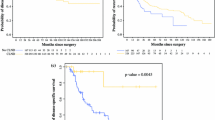Abstract
Background
Multicenter selective lymphadenectomy trial 1 (MSLT-I) defined the prognostic and potential therapeutic values of sentinel lymph node biopsy (SLNB) for intermediate-thickness melanoma. The role of completion lymphadenectomy (CLND) is, however, unclear and the subject of the ongoing MSLT-II trial.
Methods
From 2003 to 2012, patients with tumors 1–4 mm thick with positive SLNB were identified in the Surveillance Epidemiology and End Results Program registry. The patients were divided into two groups: group 1 (CLND) and group 2 (observation).
Results
The study enrolled 2172 patients, the majority of whom were white and male with extremity primaries, no ulceration, Clark level 4 invasion, and nodes 2.01–4.0 mm deep. In the univariate analysis, CLND was associated with lower mean age, male gender, primary site, number of positive nodes, and geographic region (p < 0.05). In the multivariate analysis, male gender [odds ratio (OR), 1.27] and geographic area (Michigan OR, 2.31; Iowa OR, 1.69) were associated with CLND (p < 0.05). In the survival analysis, male gender, primary site, ulceration, Clark level, and depth and number of positive nodes were associated with survival (p < 0.05), but CLND was not (p = 0.83). In the Cox regression analysis, the relationship between male gender [hazard ratio (HR), 1.14], primary site trunk versus extremity (HR, 1.3), ulceration (HR, 1.79), Clark level (2 vs. 4 HR, 3.51; 2 vs. 5 HR, 6.48), depth (HR, 1.43) and number of nodes (1 vs. 2: HR, 1.23; 1 vs. ≥3: HR, 2.52) persisted (p < 0.05). However, when CLND was included in this model, it was not associated with improved survival.
Conclusions
Age, gender, and geographic area predict the likelihood of CLND. In this retrospective study, CLND did not add survival benefit.
Similar content being viewed by others
References
Neuhaus SJ, Clark MA, Thomas JM. Dr. Herbert Lumley Snow, MD, MRCS (1847–1930): the original h-vchampion of elective lymph node dissection in melanoma. Ann Surg Oncol. 2004;11:875–8. doi: 10.1245/ASO.2004.02.031.
Morton DL, Cochran AJ, Thompson JF, et al. Sentinel node biopsy for early-stage melanoma: accuracy and morbidity in MSLT-I, an international multicenter trial. Ann Surg. 2005;242:302–11. discussion 311–3.
Cascinelli N, Morabito A, Santinami M, MacKie RM, Belli F. Immediate or delayed dissection of regional nodes in patients with melanoma of the trunk: a randomised trial: WHO melanoma programme. Lancet. 1998;351:793–6.
Balch CM, Soong S, Ross MI, et al. Long-term results of a multi-institutional randomized trial comparing prognostic factors and surgical results for intermediate thickness melanomas (1.0 to 4.0 mm). Intergroup Melanoma Surgical Trial. Ann Surg Oncol. 2000;7:87–97.
Wong JH, Cagle LA, Morton DL. Lymphatic drainage of skin to a sentinel lymph node in a feline model. Ann Surg. 1991;214:637–41.
Morton DL, Wen DR, Wong JH, et al. Technical details of intraoperative lymphatic mapping for early-stage melanoma. Arch Surg. 1992;127:392–9.
Morton DL, Thompson JF, Cochran AJ, et al. Final trial report of sentinel-node biopsy versus nodal observation in melanoma. N Engl J Med. 2014;370:599–609. doi: 10.1056/NEJMoa1310460.
Kachare SD, Brinkley J, Wong JH, Vohra NA, Zervos EE, Fitzgerald TL. The influence of sentinel lymph node biopsy on survival for intermediate-thickness melanoma. Ann Surg Oncol. 2014;21:3377–85. doi: 10.1245/s10434-014-3954-5.
Wong SL, Morton DL, Thompson JF, et al. Melanoma patients with positive sentinel nodes who did not undergo completion lymphadenectomy: a multi-institutional study. Ann Surg Oncol. 2006;13:809–16. doi: 10.1245/ASO.2006.03.058.
Fritsch VA, Cunningham JE, Lentsch EJ. Completion lymph node dissection based on risk of nonsentinel metastasis in cutaneous melanoma of the head and neck. Otolaryngol Head Neck Surg. 2016;154(1):94–104.
Bamboat ZM, Konstantinidis IT, Kuk D, Ariyan CE, Brady MS, Coit DG. Observation after a positive sentinel lymph node biopsy in patients with melanoma. Ann Surg Oncol. 2014;21:3117–23. doi: 10.1245/s10434-014-3758-7.
Kingham TP, Panageas KS, Ariyan CE, Busam KJ, Brady MS, Coit DG. Outcome of patients with a positive sentinel lymph node who do not undergo completion lymphadenectomy. Ann Surg Oncol. 2010;17:514–20. doi: 10.1245/s10434-009-0836-3.
van der Ploeg AP, van Akkooi AC, Haydu LE, et al. The prognostic significance of sentinel node tumour burden in melanoma patients: an international, multicenter study of 1539 sentinel node-positive melanoma patients. Eur J Cancer. 2014;50:111–20. doi: 10.1016/j.ejca.2013.08.023.
National Comprehensive Cancer Network, Inc. NCCN Guidelines Version 2.2016 Melanoma. http://www.refworks.com/refworks2/default.aspx?r=references|MainLayout::init (2015). Accessed 26 Apr 2016. Updated 11/25/2015.
Dzwierzynski WW. Complete lymph node dissection for regional nodal metastasis. Clin Plast Surg. 2010;37:113–25. doi: 10.1016/j.cps.2009.07.002.
Bilimoria KY, Balch CM, Bentrem DJ, et al. Complete lymph node dissection for sentinel node-positive melanoma: assessment of practice patterns in the united states. Ann Surg Oncol. 2008;15:1566–76. doi: 10.1245/s10434-008-9885-2.
Morton DL. Overview and update of the phase III multicenter selective lymphadenectomy trials (MSLT-I and MSLT-II) in melanoma. Clin Exp Metastasis. 2012;29:699–706. doi: 10.1007/s10585-012-9503-3.
Surveillance Research Program. http://seer.cancer.gov/. Accessed 9 Nov 2015.
Kretschmer L, Thoms KM, Peeters S, Haenssle H, Bertsch HP, Emmert S. Postoperative morbidity of lymph node excision for cutaneous melanoma-sentinel lymphonodectomy versus complete regional lymph node dissection. Melanoma Res. 2008;18:16–21. doi: 10.1097/CMR.0b013e3282f2017d.
Roaten JB, Pearlman N, Gonzalez R, Gonzalez R, McCarter MD. Identifying risk factors for complications following sentinel lymph node biopsy for melanoma. Arch Surg. 2005;140:85–9.
van der Ploeg AP, van Akkooi AC, Rutkowski P, et al. Prognosis in patients with sentinel node-positive melanoma without immediate completion lymph node dissection. Br J Surg. 2012;99:1396–405. doi: 10.1002/bjs.8878.
Fritsch VA, Cunningham JE, Lentsch EJ. Completion lymph node dissection based on risk of nonsentinel metastasis in cutaneous melanoma of the head and neck. Otolaryngol Head Neck Surg. 2016;154:94–103. doi: 10.1177/0194599815605494.
Leiter U, Stadler R, Mauch C, et al. Complete lymph node dissection versus no dissection in patients with sentinel lymph node biopsy positive melanoma (DeCOG-SLT): a multicentre, randomised, phase 3 trial. Lancet Oncol. 2016.
Disclosure
There are no conflicts of interest.
Author information
Authors and Affiliations
Corresponding author
Rights and permissions
About this article
Cite this article
Mosquera, C., Vora, H.S., Vohra, N. et al. Population-Based Analysis of Completion Lymphadenectomy in Intermediate-Thickness Melanoma. Ann Surg Oncol 24, 127–134 (2017). https://doi.org/10.1245/s10434-016-5460-4
Received:
Published:
Issue Date:
DOI: https://doi.org/10.1245/s10434-016-5460-4




